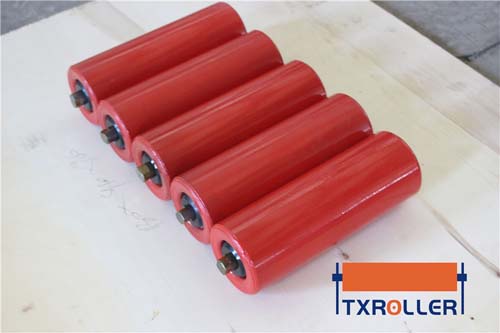Tongxiang is conveyor roller manufacturer in China.We produce the highest quality conveyor rollers.Today we introduce the thing about how to select a replacement roller for gravity roller conveyors.
Roller conveyors are used in distribution centers and shipping departments throughout the world and with proper maintenance, they should last for many years. The conveyor rollers are the items that will take the most abuse and are a likely replacement item.
Although roller conveyors are very durable, the rollers are subject to impacts, dirt and grime entering the bearings, and possibly loads higher than the roller’s capacity. Thankfully, conveyor rollers are easy to replace and doing so will extend the life of the conveyor system as a whole. Below is the information that needs to be collected before ordering replacement rollers:
Between frame width of the roller
Material of the roller tube (steel, aluminum, plastic, etc.)
Diameter of the roller and tube gauge
Axle size
Bearing type
The most important measurement to gather is the between frame width (BF) of the belt conveyor idler roller. The BF is determined by measuring the distance between the two conveyor rails, measured from the inside. This is normally a whole number such as 22″.
The next item to define is the material of the roller tube. Galvanized steel is most common as it will resist rust and is only slightly more expensive than plain steel. Lightweight aluminum roller tubes are beneficial for frequently moved conveyors. Other roller tube materials are stainless steel for food preparation and PVC or polyurethane coated rollers for non-marring applications.
The diameter of the roller is determined by measuring the outside diameter or width of the conveyor tube. Standard diameters are 1-3/8″, 1.9″ and 2-1/2″. Other specialty diameters are available. Normally standard gauges (wall thickness) that are based upon roller diameter. However, locations that are loaded by fork lifts or where items are being frequently dropped (impact loading), these rollers should have a thicker wall than the rest of the conveyor system.
The axle size is determined by measuring the diameter of a round axle or measuring from the flat side to flat side on hexagonal axles. Common axle sizes are ?” if the axle is round and 5/16″, 7/16″ and 11/16″ for hexagonal axles. Most axles are made from plain steel. The vast majority of axle types are spring retained, i.e., the axle can be depressed into the roller on one end and it will spring back. Axles may also be pin retained so that the roller may be locked in place with the use of retaining pins.
The last item to take into consideration is the bearing type. Commercial light oil bearings are the standard for most rollers. These are non-precision bearings that are free rolling and cost effective. Grease packed bearings are normally used for power conveyor applications or harsh environments. Precision ABEC 1 bearings are used when noise levels are a concern or when the rollers will be required to travel at a high speed.
In conclusion, replacement rollers are a viable method of prolonging the life of gravity conveyors. It is important to know the between frame width, the diameter and material of the tube, the axle size and the type of bearing needed. With this information the new rollers should match up perfectly with the pre-existing rollers.
We are professional conveyor equipment manufacturers,If you need more information,contact us.
Post time: Sep-29-2019


